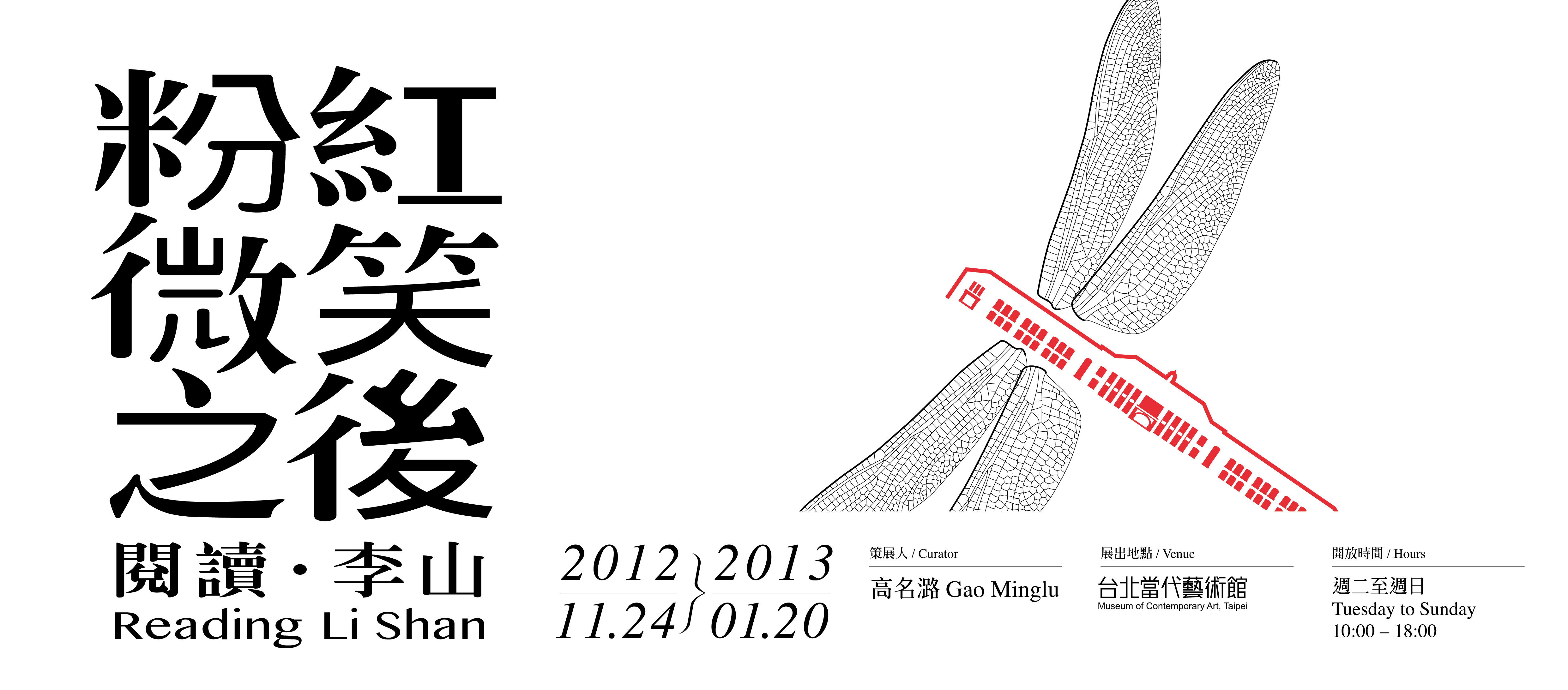

台北當代藝術館 官方網站 Museum of Contemporary Art, Taipei
Monday 星期一
10AM - 6PM



Monday 星期一
10AM - 6PM
EXHIBITIONS & EVENTS 展覽活動

2012 / 11 / 24 Sat.
2013 / 01 / 20 Sun.
10:00 - 18:00
策展人
Curator
高名潞 Gao Minglu
李山是中國當代藝術史中最重要的藝術家之一。在長達四十年的藝術生涯中,李山始終堅持思考,不斷探索,通過藝術創作反省人生和人性。八十年代初,李山參與推動了上海前衛藝術運動,並成為八十年代中國抽象藝術—「理性繪畫」的代表畫家。八十年代末,李山創作了《胭脂》系列,不僅被視為中國「政治波普」藝術的代表人物,他的「粉紅色」符號系列作品也廣為人知。從二十世紀九十年代中期,李山開始創作他的生物藝術—《閱讀》系列。本次展覽展示的就是李山過去17年中對生物藝術的思考、構想、實驗以及他創作的部分作品。 Li Shan is one of the most important artists in the history of Chinese contemporary art. In his four-decade long artistic career, Li Shan has always insisted on constantly contemplating, exploring and reflecting on life and human nature through artistic creation. In the early eighties, Li Shan participated in the promotion of avant-garde art movement and became a representative painter of “rational painting”, Chinese abstract art, in the mid-eighties. At the end of the eighties, Li Shan created Yan Zhi (rouge) series, which led him not only be regarded as the representative of the “political pop” art, his series of work with “pink” symbols was also well known. Since the mid-nineties, Li Shan has begun creation of his bio-art—the Reading series. This exhibition is to present Li Shan’s thinking, ideas, and experiments regarding bio-art over the past 17 years by presenting a part of his works. 生物藝術無疑是二十一世紀文化的尖端學科。李山通過視覺方式把生物基因重組的試驗結果展示給大眾。台北當代藝術館本次舉辦的【粉紅微笑之後:閱讀•李山】分別展出了李山九十年代以來聚焦於生物藝術的思考和創作。包括1995年生物藝術的閱讀筆記;1998年在紐約創作的生物藝術方案;數位影像製作的昆蟲和藝術家的結合體;一個轉基因青蛙(包括概念、圖片和影像紀錄等);而李山結合科學認知和藝術想像創作的100幅轉基因生物形象,簡直就是二十一世紀版的《山海經》怪獸大全集!在這個展覽中,觀眾可以同時觀賞李山將生物藝術極簡化、觀念化和最大化、實體化的兩種呈現方式,前者例如用轉基因生物理論濃縮成一本新的《聖經》,或者如用20萬隻蜻蜓翅膀把當代藝術館外牆立面整體包覆起來的奇觀勝景。 Bio-art is undoubtedly a state-of-the-art cultural discipline of the 21st century. Li Shan presented the test results of biological genetic recombination to the public through visual means. For the exhibition Reading Li Shan organized by the Museum of Contemporary Art, Taipei exhibited Li Shan’s thinking and creation focused on bio-art since the nineties. Exhibited items included his reading journals on bio-art in 1995, a bio-art proposal created in New York in 1998, a fused image of an insect and an artist produced digitally, and a transgenic frog (including concept, pictures, and video records, etc.); the hundreds of images of transgenic creatures created by combining scientific knowledge and artistic imagination are truly the 21st century version of the monster extravaganza of the Shan Hai Jing, an ancient Chinese volume of whimsical stories! At the exhibition, viewers can simultaneously appreciate the two methods Li Shan used to minimalize, conceptualize, and maximize bio-art. For example, he condensed the theories of genetically modified organisms into a new Bible. Along with this, he covered the outside walls of the museum with wings of 200 thousand dragonflies, creating a spectacular view. 李山的生物藝術作品大約分這幾個階段:1.生物+非生物,即用動物皮毛來包汽車或飛機等能發動的無機物。2.昆蟲+哺乳動物即把物種兩級的生物基因相融合。3.用人或自身+昆蟲等小生物即把人與其他生物相融合。4.通過生物基因工程製作新的生物物種,《南瓜》計畫作品。李山的生物藝術把想像和實證、玄學和科學結合在一起。李山的生物藝術是一個批判人類中心主義的宣言。李山的生物藝術試圖指出,迄今為止,人類以人文道德為規範,建立了不公平世界之同時,也干擾了自然的秩序。 Li Shan’s works of bio-art came in several stages: 1. Biotic + Abiotic, i.e., wrapping inorganic objects such as cars and planes in animal hides. 2. Insects + Mammals, i.e., fusing the genomes of animals of two different classes. 3. Human or himself + Insects or other small organisms, i.e., fusing human and other living things. 4. Produce new biological species through biogenetic engineering, or the Pumpkin project. Li Shan’s bio-art combines imagination, empiricism, metaphysics, and science. It is a declaration of critique of anthropocentrism and attempts at pointing out that, to date, humans have adopted humanistic morals as norms and through which have created an unfair world and also interfered with the natural order.
MORE
LESS
李山是中國當代藝術史中最重要的藝術家之一。在長達四十年的藝術生涯中,李山始終堅持思考,不斷探索,通過藝術創作反省人生和人性。八十年代初,李山參與推動了上海前衛藝術運動,並成為八十年代中國抽象藝術—「理性繪畫」的代表畫家。八十年代末,李山創作了《胭脂》系列,不僅被視為中國「政治波普」藝術的代表人物,他的「粉紅色」符號系列作品也廣為人知。從二十世紀九十年代中期,李山開始創作他的生物藝術—《閱讀》系列。
Li Shan is one of the most important artists in the history of Chinese contemporary art. In his four-decade long artistic career, Li Shan has always insisted on constantly contemplating, exploring and reflecting on life and human nature through artistic creation. In the early eighties, Li Shan participated in the promotion of avant-garde art movement and became a representative painter of “rational painting”, Chinese abstract art, in the mid-eighties. At the end of the eighties, Li Shan created Yan Zhi (rouge) series, which led him not only be regarded as the representative of the “political pop” art, his series of work with “pink” symbols was also well known. Since the mid-nineties, Li Shan has begun creation of his bio-art—the Reading series.
CLOSE
CLOSE
著作權聲明
台北當代藝術館尊重他人著作權,台北當代藝術館服務條款亦明定,網友使用台北當代藝術館服務不得侵害他人之著作權,因此,台北當代藝術館呼籲使用者同樣尊重他人之著作權。如果您認為台北當代藝術館網站中之任何網頁內容或網友使用台北當代藝術館服務已侵害您的著作權,建議您利用本處理辦法提出檢舉,台北當代藝術館客服中心將儘速為您處理:
若台北當代藝術館網站中之任何網頁內容或網友使用台北當代藝術館服務已侵害您的著作權,請您填寫:「 著作權侵權通知書」,且依該通知書所載提供下列資料及聲明,並以傳真的方式通知台北當代藝術館:
1、著作權人之簽名、或著作權人之代理人之簽名、相關權利證明文件及著作權之內容,例如:已發行書籍之封面及相關頁面、發表於網路中之網頁內容列印紙本及其網址。
2、侵害著作權之內容所在的網頁及網址。
3、您的聯絡地址、電話等資料。
4、書面聲明您確信該網頁內容的使用行為是未經過著作權人、其代理人或法律的授權。
5、書面聲明您於通知書所載相關資料均為真實,且您是著作權人或著作權人之代理人而為上開聲明。
若台北當代藝術館網站中之任何網頁內容或網友使用台北當代藝術館服務已侵害您的著作權,請您填寫:「 著作權侵權通知書」,且依該通知書所載提供下列資料及聲明,並以傳真的方式通知台北當代藝術館:
1、著作權人之簽名、或著作權人之代理人之簽名、相關權利證明文件及著作權之內容,例如:已發行書籍之封面及相關頁面、發表於網路中之網頁內容列印紙本及其網址。
2、侵害著作權之內容所在的網頁及網址。
3、您的聯絡地址、電話等資料。
4、書面聲明您確信該網頁內容的使用行為是未經過著作權人、其代理人或法律的授權。
5、書面聲明您於通知書所載相關資料均為真實,且您是著作權人或著作權人之代理人而為上開聲明。
隱私權保護政策
台北當代藝術館非常重視用戶的隱私權,因此制訂了隱私權保護政策。請你細讀以下有關隱私權保護政策的內容。
隱私權保護政策的適用範圍
1、隱私權保護政策內容,包括台北當代藝術館如何處理在用戶使用網站服務時收集到的身份識別資料,也包括台北當代藝術館如何處理在商業伙伴與台北當代藝術館合作時分享的任何身份識別資料。
2、隱私權保護政策不適用於台北當代藝術館以外的公司,也不適用於非台北當代藝術館所僱用或管理的人員。
3、台北當代藝術館在你註冊台北當代藝術館帳號、使用台北當代藝術館的產品或服務、瀏覽台北當代藝術館網頁、參加宣傳活動或贈獎遊戲時,台北當代藝術館會收集你的個人識別資料。台北當代藝術館也可以從商業夥伴處取得個人資料。
4、當你在台北當代藝術館註冊時,我們會問及你的姓名、電子郵件地址、出生日期、性別、職位、行業及個人興趣等資料。你在台北當代藝術館註冊成功,並登入使用我們的服務後,我們就會認識你。
5、台北當代藝術館也自動接收並紀錄你瀏覽器上的伺服器數值,包括互聯網協定位址 (IP Address) 、台北當代藝術館cookie中的資料及你要求取用的網頁紀錄。
6、台北當代藝術館會使用資料作以下用途:改進為你提供的廣告及網頁內容、完成你對某項產品的要求及通知你特別活動或新產品。
7、台北當代藝術館不會向任何人出售或出借你的個人識別資料。
8、在以下的情況下,台北當代藝術館會向政府機關、其他人士或公司提供你的個人識別資料:與其他人士或公司共用資料前取得你的同意。
9、需要與其他人士或公司共用你的資料,才能夠提供你要求的產品或服務。
10、向代表台北當代藝術館提供服務或產品的公司提供資料,以便向你提供產品或服務 (若我們沒有事先通知你,這些公司均無權使用我們提供的個人資料,作提供產品或服務以外的其他用途)。
11、應遵守法令或政府機關的要求。
12、我們發覺你在網站上的行為違反 台北當代藝術館服務條款或產品、服務的特定使用指南。
13、其他依「個人資料保護法」或政府法令應公開之資料。
14、為了保護使用者個人隱私, 我們無法為您查詢其他使用者的帳號資料,請您見諒!若您有相關法律上問題需查閱他人資料時,請務必向警政單位提出告訴,我們將全力配合警政單位調查並提供所有相關資料,以協助調查及破案!
15、 台北當代藝術館會到你的電腦設定並取用台北當代藝術館cookie。
16、台北當代藝術館容許在我們網頁上擺放廣告的廠商到你的電腦設定並取用cookie。其他公司將根據其自訂的隱私權保護政策,而並非本政策使用其cookie。其他廣告商或公司不能提取台北當代藝術館的cookie。
17、當台北當代藝術館進行與其產品及服務有關的工作時,會使用 web beacons 進入我們的網站網絡,提取cookie使用。
18、台北當代藝術館賦予你在任何時候修改個人台北當代藝術館帳號資料及偏好設定的權力,包括接受台北當代藝術館通知你特別活動或新產品的決定權。